
January 2007
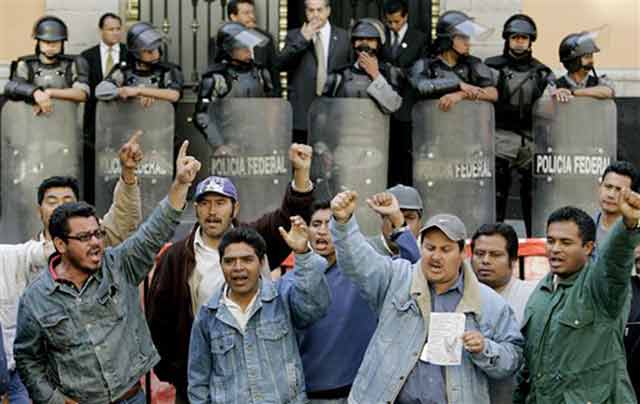
Protest in Mexico City against bloody cop attack on Oaxaca teachers, June 14.
(Photo: Eduardo Verdugo/AP)
Forge a Revolutionary Workers Party!
As 2007 dawns, Mexico is
still reeling from ten months of sharp class conflict. A new government
has
taken office vowing to employ “the full weight of the state” against
those who
defy it. Felipe Calderón, the reactionary president imposed by
the Federal
Elections Tribunal over massive protests, wants above all to assure
Wall Street
and Washington that he will “preserve economic stability.” The
appetites of the
head of the right-wing National Action Party (PAN) for a “strong state”
are
evident, but he comes into office as the weakest government of any in
recent
history. Not only did protesters shut down the capital’s main square
and main
thoroughfare for six weeks last summer protesting electoral fraud,
workers,
peasants and teachers repeatedly defeated police and troops in a series
of
pitched battles over the last year. Although a six-month mass strike in
the
southern state of Oaxaca ended with an eruption of cop violence and
hundreds of
arrests, the tens of thousands of strikers are unbowed. The dramatic
clashes of
2006 have sown the seeds of revolution, as the strikes of 1906-07
signaled the
coming of the Mexican Revolution of 1910. But the key element for a
victorious
outcome is absent: a revolutionary vanguard with the program and
determination
to sweep away the inhuman exploitation and mass poverty of capitalism
and set
out on the road of international socialist revolution.
The response of Mexico’s
rulers to last year’s unrest has been rampant militarization. Twice in
recent
months, the government of outgoing president Vicente Fox surrounded
Congress
with a ring of metal barricades and thousands of troops and riot police
and
kept the area sealed off for days. Calderón was sworn in as head
of state by a
military officer at a private midnight ceremony in the presidential
residence,
Los Pinos. He slipped into Congress the next day by a back door for an
official
appearance that lasted less than five minutes, then ducked out again.
The new ruler
started off the new year by donning a military cap and jacket as
commander in
chief of the armed forces to review Mexican Army units in
Michoacán, where they
are allegedly fighting drug traffickers. He simultaneously launched a
“Plan
Tijuana,” supposedly directed at the drug kingpins who dominate the
city under
Institutional Revolutionary Party (PRI) mayor Jorge Hank Rhon. But the
plan
mainly consisted of searching vehicles and carrying out military
patrols in
neighborhoods considered to be “conflict” zones looking for stolen
autos,
contraband and networks for funneling undocumented immigrants across
the border
to the United States. In other words, it was really about getting the
population used to police-state controls.
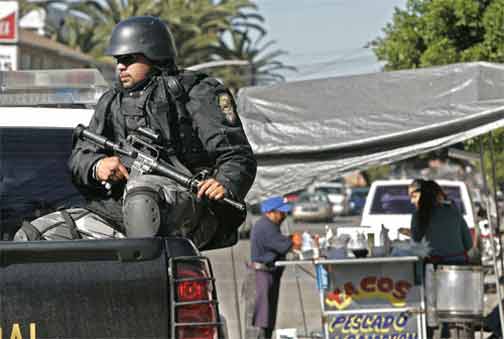 Mexican
Federal Police patrol Colonial Libertad in Tijuana, accustoming the
population to police-state controls. (Photo: Don Bartletti/Los
Angeles Times)
Mexican
Federal Police patrol Colonial Libertad in Tijuana, accustoming the
population to police-state controls. (Photo: Don Bartletti/Los
Angeles Times)
Calderón is also
militarizing his administration. Among the officials participating in
his
Michoacán military review were the new minister of the interior
(Gobernación),
Francisco Ramírez Acuña, who gained notoriety as governor
of Jalisco by his
heavy-handed jailing of anti-globalization protesters; the new attorney
general, Eduardo Medina Mora, formerly head of the Federal Preventive
Police
(PFP); and Michoacán governor Lázaro Cárdenas
Batel, who last April sent state
police to join the PFP in assaulting striking steel workers in the city
named
after his grandfather, President Lázaro Cárdenas
Ríos. Now the administration
plans to fuse the PFP and Federal Investigative Agency to create a
“super-police” under the general commanding the combined
police/military force
in Oaxaca, Ardelio Vargas. The purpose of this operation is to provide
security
and “stability” for capital. Calderón explained to the
convention of the
Mexican Stock Market last October, “As head of the federal executive I
am
committed to creating an environment favoring investment and
employment…,
promoting competitiveness,” etc. After the media show of going after narcos
and coyotes is over, his beefed up police apparatus
will get
down improving
the business “environment” by repressing workers and other opponents.
In his speech to the stock
marketeers, Calderón vowed to maintain Mexico’s “leading
position in attracting
investment.” Police “reform” is high on the agenda of foreign investors
and
pundits, who may be annoyed by the pervasive corruption and ties to
drug gangs,
but were livid at the spectacle of federal police retreating before
youths
armed with slingshots and “Molotov cocktails” in Oaxaca last November
2.
Keeping Wall Street money men happy is uppermost in the minds of
Mexico’s
rulers in recent years, as imperialist bankers have bought up 80
percent of the
country’s financial institutions. What they are really after is
grabbing
Mexico’s enormous oil (nationalized by President Cárdenas in
1938) and
hydroelectric resources. This would require an amendment to Mexico’s
constitution
and likely provoke a battle royal with workers unions and nationalist
politicians. Speaking out of one side of his mouth, Calderón
tells
international high finance that he will accommodate them (a U.S. Energy
Information Agency report says the new president will “allow private
companies
to participate in new energy projects”) while for domestic consumption
he vows
he won’t privatize oil or electricity. The double talk covers a
contradiction
which cannot be maintained much longer.
The imperialists are
getting impatient with the pace of economic “reform” in Mexico and are
demanding drastic action. Last fall, the British Economist (18
November
2006) published a special survey on Mexico under the title, “Time to
Wake Up.”
It called on Calderón to be “far bolder than his predecessor in
tackling the
many vestiges of the old order that are still holding the country
back.” These
“vestiges” include going after “monopoly power . . . from the teachers’
union
to Pemex, the state oil monopoly.” But like Fox before him, the
technocratic
president tied to the ultra-rightist Catholic secret society El Yunque
hesitates to tear down Mexico’s corporatist structure all at once, for
fear
that the country could come apart. Other provocative demands by the
international bankers include extending the sales tax (IVA) to medicine
– which
Fox tried but failed to push through Congress – and ending subsidies of
basic
food products, like tortillas. In November, the government raised the
price of
subsidized milk by 28 percent, while in December it increased the
minimum wage
by less than 2 pesos (20 cents) a day, not enough to buy one egg and
one
aspirin. Now the Organization for Economic Cooperation and Development
is
telling Mexico’s government to privatize the ejidos, land
belonging to
peasant and Indian communities. Such calls are designed to provoke a
revolt.
The main thing holding it
off so far has been the porous border to the U.S., which acted as a
kind of
safety valve: instead of protesting, the dispossessed headed north. Now
the
border is being closed, and pressure is building toward a social
explosion. The
North American Free Trade Agreement (NAFTA) has devastated Mexican
agriculture.
Millions of poor peasants have been forced off their land because their
corn
cannot compete on the market with the (highly subsidized) U.S. grains.
As
trainloads of corn from Iowa headed south on the (now U.S.-owned)
railroads to
Mexico, Mexican peasants headed north to Iowa to find work in packing
plants.
Now the situation in the countryside is about to become even more
dramatic, as
tariffs on imported corn are due to fall from 27 percent to 16 percent
this
month, and to 0 by January 2008. For a time the maquiladora
free-trade
zone plants managed to absorb many young workers producing electronic
goods,
auto parts and clothing for the giant U.S. market. But in the last
several
years hundreds of thousands of maquiladora workers have lost
their jobs
as fly-by-night entrepreneurs shut down plants to head for even
lower-wage
havens, particularly China. So while racist reactionaries in the United
States
froth about Mexican workers “stealing American jobs,” their
counterparts south
of the border rail against the Chinese deformed workers state for
“stealing
Mexican jobs.”
For more than six decades,
the one-party regime of the PRI was able to maintain “economic
stability” with
a capitalist economy in which key sectors (energy, heavy industry,
transport,
finance) were in the hands of the state. They fostered the growth of a
domestic
capitalist class with cheap energy prices and cheap credit, while
keeping a lid
on labor protest with corporatist “unions” which acted as labor cops
for the
bosses. Leaders were integrated into the PRI-government apparatus,
workers in
key industries were thrown some crumbs in the form of job security and
social
benefits, while wages were kept low and dissidents brutally repressed.
Over the
last two and a half decades, PRI presidents De la Madrid, Salinas and
Zedillo
and then Fox of the PAN have been dismantling this semi-bonapartist
regime bit
by bit. Salinas sold off more than 1,200 state-owned companies to his
cronies,
making instant billionaires of some and turning Carlos Slim (owner of
the
privatized Teléfonos de México) into the third-richest
man in the world. As the
super-rich wallow in dollars, the already miserable incomes of Mexican
are
falling while social security is gutted. Mexico is hurtling toward a
crisis.
The only question is the outcome.
“Popular Democracy” or
Workers Revolution
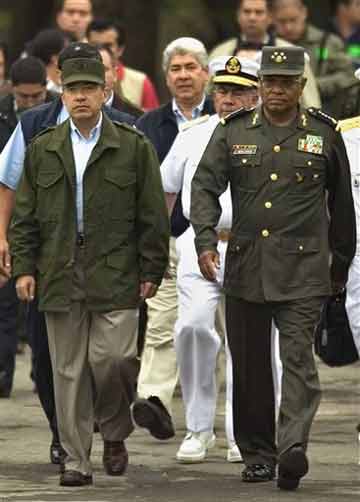 The “president elect” imposed by the
Federal Elections Tribunal, Felipe Calderón, wears a military
cap while reviewing the troops together with his secretary of war,
Guillermo Galván. (Photo: Guillermo Arias/AP)
The “president elect” imposed by the
Federal Elections Tribunal, Felipe Calderón, wears a military
cap while reviewing the troops together with his secretary of war,
Guillermo Galván. (Photo: Guillermo Arias/AP)
Beginning with the deaths
of 65 coal miners in the state of Coahuila last February, Mexico has
been
convulsed by almost uninterrupted labor unrest. When Fox’s labor
minister tried
to remove the head of the corporatist miners “union,” Napoleón
Gómez Urrutia,
as punishment for slipping the leash and talking of “industrial
homocide” at
the Pasta de Conchos mine, more than 300,000 mine and metal workers
walked out
in protest. Gómez Urrutia called it off after a few days, but
steel workers at
the Sicartsa-Las Truchas plant in Lázaro Cárdenas
(Michoacán) and copper miners
at Cananea and Nacozari (Sonora) stayed out on strike for months. The
miners
lost and were forced back to work with hundreds fired, but the steel
strikers
won, with an 8 percent wage increase, full pay for strike days, a
US$700 bonus
and increased benefits. This victory was a dramatic demonstration of
the
workers’ power, having occupied the plant and defended it by driving
off an
assault by federal, state and local police along with marines on April
20, at a
cost of 2 strikers killed. But the impact of the strike victory
remained
limited as the struggle was confined to strictly trade-union bounds.
The cop-military attack on
the Sicartsa plant was followed two weeks later by a brutal police
assault on
peasants and townspeople in San Salvador Atenco, in Mexico state near
the
Federal District. It began with the arrest of some flower sellers by
police of
the town of Texcoco, whose PRD mayor wanted to ban street vendors in
order to
make way for a Wal-Mart store. There, too, the police were driven out,
only to
return with thousands of federal and
state police who brutally beat and arrested hundreds. Several dozen
women
protesters were sexually molested and raped after being detained. This
set off
worldwide protests initiated by the “Other Campaign” of the Zapatista
National
Liberation Army (EZLN). But by far the largest struggle was that
launched by
striking teachers in the state of Oaxaca, which began in late May and
lasted
until the end of November. On June 14, the murderous state governor,
Ulises
Ruiz Ortiz, ordered an army of several thousand riot police to evict a
strikers’ encampment (plantón) in the center of Oaxaca
city. But the
40,000 teachers fought back and drove out the cop attackers. From then
until
the PFP invaded at the end of October, the state capital was in the
hands of
the strikers and their allies of the Popular Assembly of the Peoples of
Oaxaca
(APPO).
The story of that
convulsive struggle is recounted in a series of articles in this issue
and the previous issue of The Internationalist (No. 24, Summer
2005). Following the violent arrest of hundreds and imposition of a de
facto
state of siege in Oaxaca on November 25, the focal point of
mobilization has
shifted to the demand for immediate release of the detainees, several dozen of whom are still in jail, and
dropping the trumped-up charges. More than 20 strike supporters were
killed
over the course of the six-month battle. But while the PRI
governor-assassin
Ruiz Ortiz crows victory and his PAN allies in Mexico City proclaim
that it’s
all over, the working, poor and indigenous people of Oaxaca continue to
fight.
On January 6, “Three Kings Day,” when children in Mexico traditionally
receive
presents, the APPO held an event to give toys to the children whose
parents are
behind bars, prisoners in the class war. Typically, the state
government sent
riot cops to keep the kids out of the Plaza of Santo Domingo, claiming
the need
to “provide security for tourists.” Hundreds of children showed up
anyway, some
with signs saying the best present would be for Ruiz to leave (La
Jornada,
7 January).
While keeping up the
struggle, it is time to take stock and draw the lessons of more than
half a
year of hard combat. What are those lessons? The APPO leaders who have
not been
jailed are focused on getting their comrades out of prison,
particularly APPO
spokesman Flavio Sosa, a demand that should be taken up by the entire
workers
movement, in Mexico and internationally. Militant sectors want to
settle
accounts with Enrique Rueda Pacheco, the leader of the 70,000-strong
Oaxaca
teachers union, Section 22, SNTE-CNTE, who broke ranks and ordered
strikers
back to work at the beginning of November, leaving APPO supporters
alone on the
barricades. Thousands of teachers refused to obey and now rightly want
to throw
out Pacheco for strikebreaking. At the same time, the leader of the
national
corporatist teachers “union” (SNTE), Elba Esther Gordillo, has cashed
in on her
crucial electoral support to Calderón, placing her agents in
control of the
secretariat of public education, and setting up a new Section 59 in
Oaxaca made
up of teachers who scabbed during the strike. Meanwhile, combative
students and
youth who played a key role in the victorious November 2 defense of
Oaxaca
University sharply denounce the APPO leaders for abandoning them after
November
25.
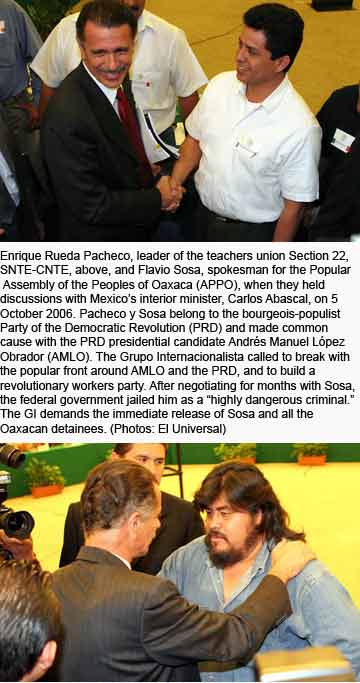 The
militants’ complaints
are utterly valid, but by posing the issue in essentially personal
terms, on
the terrain of simple militancy vs. betrayal, they fail to address the
political reasons for the “moderates” stab in the back. The basic fact
is that
the leaders both of the APPO (Sosa) and of the Oaxaca teachers union
(Rueda
Pacheco), as well as of the new scab section of the national SNTE, all
are
supporters of the bourgeois populist Party of the Democratic Revolution.
Sosa, while he may affect the look of a student radical, is a national
counselor of the PRD, who in 2000 even joined those PRDers calling to
vote for
the rightist Fox as a “lesser evil” to the PRI. While they engaged in
combative
tactics locally, nationally they looked to the PRD. APPO’s support to
PRD
presidential candidate Andrés Manuel López Obrador in the
July 2 elections was
seen by many Oaxaca strikers as a “tactical” move against Ulises Ruiz
Ortiz: a
vote for AMLO against URO. But for the APPO leaders it was strategic.
When they
traveled to the capital for negotiations, they sat down in the PRD plantón
in the Mexico City Zócalo. And just as López Obrador
didn’t intend his street
protests to challenge the bourgeois state, which they didn’t, the
Oaxacan
leaders quite consciously never raised demands going beyond the limits
of
capitalism.
The
militants’ complaints
are utterly valid, but by posing the issue in essentially personal
terms, on
the terrain of simple militancy vs. betrayal, they fail to address the
political reasons for the “moderates” stab in the back. The basic fact
is that
the leaders both of the APPO (Sosa) and of the Oaxaca teachers union
(Rueda
Pacheco), as well as of the new scab section of the national SNTE, all
are
supporters of the bourgeois populist Party of the Democratic Revolution.
Sosa, while he may affect the look of a student radical, is a national
counselor of the PRD, who in 2000 even joined those PRDers calling to
vote for
the rightist Fox as a “lesser evil” to the PRI. While they engaged in
combative
tactics locally, nationally they looked to the PRD. APPO’s support to
PRD
presidential candidate Andrés Manuel López Obrador in the
July 2 elections was
seen by many Oaxaca strikers as a “tactical” move against Ulises Ruiz
Ortiz: a
vote for AMLO against URO. But for the APPO leaders it was strategic.
When they
traveled to the capital for negotiations, they sat down in the PRD plantón
in the Mexico City Zócalo. And just as López Obrador
didn’t intend his street
protests to challenge the bourgeois state, which they didn’t, the
Oaxacan
leaders quite consciously never raised demands going beyond the limits
of
capitalism.
Yet the pitched battles in
the streets of Oaxaca that defeated police attacks, the erection of
thousands
of barricades throughout the city, the takeover of several dozen towns
around
the state by striking teachers, the teachers’ “police” squads that kept
order
in the occupied state capital – these aspects of a hard-fought class
struggle
did begin to present an implicit challenge to the capitalist
regime. But
they lacked an explicit revolutionary political perspective. Many
radicals
seized upon these initial steps to present a picture of the struggle in
Oaxaca
as if it were already a revolutionary situation, or on the
verge of
becoming one. This make-believe vision was synthesized in the
propaganda that
circled the globe about a Oaxaca Commune. We warned (see “A Oaxaca
Commune?”
page 36) that this substituted fantasy for fact, and that in any case,
the goal
of Marxists would not be an isolated commune in the most economically
impoverished state of Mexico but a revolutionary proletarian
mobilization
throughout the country and particularly in the capital. We also
emphasized that
those who equated the Oaxaca struggle with the 1871 Paris Commune in
terms of
“democracy” misread the class nature of the latter, which
Marxists from
Marx and Engels to Lenin and Trotsky hailed as the first workers
government
in history.
In the aftermath of
November 25, there have been different responses on the radical left.
Some,
like the Liga de Trabajadores por el Socialismo (Socialist Workers
League) have
simply kept on with the fiction of a Oaxaca Commune, calling it “An
Initial
Revolutionary Attempt” and saying it’s necessary to continue onward and
upward
from this “new stage in the class struggle” (in its dossier, “Crisis of
the
Regime and Lessons of the Oaxaca Commune,” 29-31 December 2006). This
misses
the fundamental point that the roiling mass strike in Oaxaca was
defeated not
by bloody repression, although that was very real, but because the
political
perspective of the APPO and Section 22 leaders had taken them to a
dead-end.
APPO supporters came out by the thousands and defeated the PFP on
November 2,
but following the November 25 police attack they did not come out to
defend
Radio APPO a second time. Why not? Not because they lacked courage and
the will
to fight. They showed that over and over through half a year of
battles. It was
because their leaders had shown them no way forward. Would they
endlessly go up
against the tanquetas (armored personnel carriers) with
slingshots and
stones until the militarized police carried a large-scale massacre with
live
ammunition? What kind of a perspective is that?
Another current, the
Militant tendency, flatly proclaimed a defeat, writing laconically,
“The
Commune of Oaxaca reached its end” (“Lessons of Oaxaca,” Militante,
December 2006). Similar to the LTS, Militante continues to insist that
the APPO
represented “embryos of soviets” – leaving aside the fact that, while
various
unions participated in the APPO, it was not based on the
proletariat,
but rather represented a multi-class conglomeration of the various
sectors in
struggle (teachers, indigenous peoples, students). Militante says,
rightly that
the alternative was revolution or counterrevolution, and that the
responsibility lies with the leadership. According to them, Pacheco
betrayed,
while Sosa, having only an “empiricist” program, “unfortunately wasn’t
up to
the task.” How’s that for a “Marxist” explanation! What Militante wants
to
sidestep is the fact that both Pacheco and Sosa, and the rest of the
APPO
leadership and most of the teachers union tops, supported the PRD.
And
the reason for this omission is simple: Militante poses as the “Marxist
tendency” of this bourgeois party. They criticize “APPO and
AMLO” for
not calling for a united front against repression and pushing for “an
insurrectionary general strike”! How could they?! Looking to a
bourgeois
politician to call a workers uprising only creates dangerous illusions.
And for
its part, Militante gave political support to both APPO and AMLO.
The largest left-wing
political tendency active in the struggle in Oaxaca was the Communist
Party of
Mexico (Marxist-Leninist) and its Revolutionary Popular Front, which
had
supporters in the leadership both of the APPO and the teachers’ Section
22.
When the bourgeoisie called on APPO leaders to rein in the “radicals,”
the FPR
was who they had in mind. The PCM(m-l) is an aggressively Stalinist
party,
hailing “the immortal scientific ideology of Marx, Engels, Lenin and
Stalin”
and prominently displaying the portrait of the man Leon Trotsky
accurately
described “the great organizer of defeats” in the zócalos of
Oaxaca and Mexico
City. With the radicalization of struggles by Mexican workers and youth
in
recent years, notably the 1999 National University (UNAM) strike and
2004
mobilization by Social Security workers, and in 2006 the mine and metal
workers’ and Oaxacan teachers’ struggles, the PCM has often struck a
combative
pose. Its posters declare, “For the Victory of the Proletarian
Revolution” and
denounce capitalism. But at bottom, its political program is the same
old
Stalinist-Menshevik line of a “two-stage” revolution, in which the
first stage
is (bourgeois) democratic. Thus whatever their red flags and posters
may
suggest, these Stalinists are not fighting for workers revolution
in the
here and now.
A recent pamphlet by the
PCM(m-l) and FPR, Considerations on the Revolutionary-Democratic
Process of
the Peoples of Oaxaca (November 2006) interestingly had a first
edition
referring in the introduction to a “Commune that is questioning the
bases of
the system of domination” by the capitalist ruling class, while in the
second
edition the Commune has been disappeared. The document goes on a great
length
describing the ravages of capitalism, which has condemned
three-quarters of the
population of Oaxaca to a life of poverty, massive illiteracy,
denouncing the
“Senate of illustrious bandits” and the “House of merchants.” It talks
of the
“big hotel owners” who are in league with the “old-line caciques”
(political bosses) and “puppets like Felipe Calderón.” But while
it talks of
the “fascists” PRI-AN coalition, and of the “inconsistency of the
social-traitors of the PRD,” it pointedly does not criticize
López Obrador.
Rather than attacking the capitalist state, it refers to the “financial
oligarchy and its state.” And it ends up calling for a “new popular
democratic
republic based on the power of the masses through their popular
assemblies.” In
other words, their operational program is for a bourgeois
republic
governed by an equivalent of the APPO.
For a
Leninist-Trotskyist
Workers Party
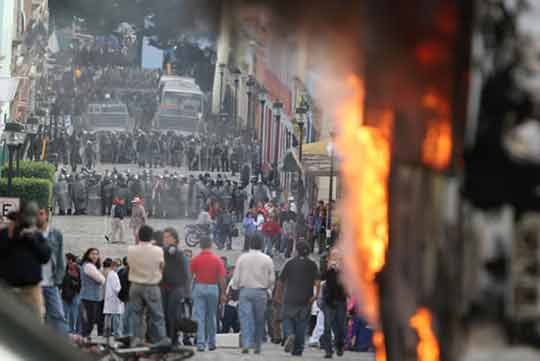 Supporters of the Popular Assembly of the
Peoples of Oaxaca (APPO) confront federal police on November 20.
Forging a revolutionary
proletarian leadership is key.
Supporters of the Popular Assembly of the
Peoples of Oaxaca (APPO) confront federal police on November 20.
Forging a revolutionary
proletarian leadership is key.
(Photo: El Universal)
The various tendencies of
the centrist and reformist Mexican left adopt a fundamentally
anti-Marxist view
of the relationship between democratic and socialist struggles. All of
them
call for a new constituent assembly or revolutionary convention,
harking back
to the Mexican Revolution of 1910-1917. And their identification of
“people’s
assemblies” with soviets, the organs of proletarian rule in
the Russian
Revolution, is common to the vast majority of the left in Latin
America. When a
“National and Indigenous Peoples’ Assembly” was formed in Bolivia at
the height
of the 2005 worker-peasant uprising, a chorus of ostensibly
revolutionary
leftists proclaimed this APNO to be “soviets on the altiplano.” That
body
turned out to be stillborn, as we in the League for the Fourth
International
pointed out at the time, and was never more than a cartel of
left-talking bureaucrats.
So when the APPO in Oaxaca took shape with undeniable mass support,
those who
were disappointed in Bolivia took heart and again proclaimed the advent
of
“soviets,” this time in the indigenous heartland of Mexico. This disoriented
the struggle by implying that what was needed was simply to intensify
and
radicalize the APPO’s struggle instead of transforming and extending it
to the
powerful industrial proletariat.
As in every class battle,
the question of leadership is key. Militante proclaims that “this
defeat has
provoked the demoralization of the Oaxacan masses,” when these
pseudo-Trotskyists are actually describing their own demoralization.
The
struggle in Oaxaca suffered a serious setback and temporary defeat, but
it
could flare up again tomorrow. What the Oaxacan masses require is a
vanguard
with a proletarian revolutionary program instead of all the talk about
an
amorphous “people” including sectors of the bourgeoisie. Just before
the
crackdown in Oaxaca, Zapatista Subcomandante/Delegado Zero Marcos
declared, “We
are on the eve of a great uprising or a civil war” (La Jornada,
24
November). After the repression of November 25, Juchitecan painter
Francisco
Toledo said he felt Oaxaca is “almost on the verge of a civil war” and
that the
“Oaxacan political class has to disappear in order to change the
situation in
the state” (La Jornada, 4 December 2006). Today
the immediate issue posed is to free the Oaxacan detainees.
In Spain in the 1930s, the struggle to free thousands of Asturian
miners imprisoned
after the failed uprising of 1934 was a key factor leading to the Civil
War of
1936-39. But that struggle was hijacked and subjugated to the
bourgeoisie
through the Popular Front.
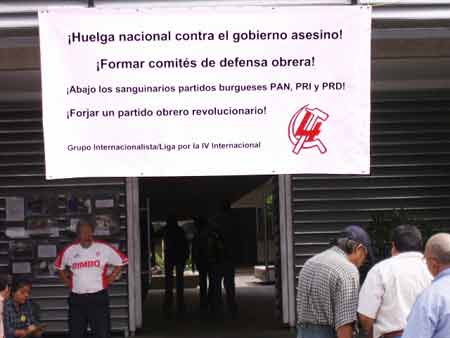 Banner of Grupo
Internacionalista at November 11 rally by SITUAM (Union of Workers of
the Metropolitan Autonomous University) in Mexico City in defense of
Oaxaca teachers: “For a
National Strike Against the Murderous Government! Form Workers Defense
Committees! Down With the Bloody Bourgeois Parties PAN, PRI and PRD!
Forge a Revolutionary Workers Party!” (Photo: El
Internacionalista)
Banner of Grupo
Internacionalista at November 11 rally by SITUAM (Union of Workers of
the Metropolitan Autonomous University) in Mexico City in defense of
Oaxaca teachers: “For a
National Strike Against the Murderous Government! Form Workers Defense
Committees! Down With the Bloody Bourgeois Parties PAN, PRI and PRD!
Forge a Revolutionary Workers Party!” (Photo: El
Internacionalista)
The Grupo Internacionalista
has called repeatedly to break from the popular front around
López Obrador and
the PRD, just as we warned for years that the Cárdenas popular
front was
diverting workers from organizing a class struggle against the PRI
regime.
Contrary to those (such as the Grupo Espartaquista de Mexico) who deny
the
existence of a popular front in Mexico, this popular front has now been
formally constituted with the signing of a document of “strategic
alliance”
between the “independent” pro-PRD unions, several peasant groups and
López
Obrador’s Broad Progressive Front (FAP), which including the PRD, the
Party of
Labor (PT) and the Democratic Convergence, all of them bourgeois
parties. As
new struggles loom, over Calderón’s plans for privatization of
electrical
energy for example, it will be crucial to call on the unions, such as
the SME
(Mexican Electrical Workers Union), to break from the popular front
with AMLO
and the PRD, and to instead fight to build a revolutionary workers
party.
After the battle of Sicartsa and throughout the struggle in Oaxaca, we
called
for the formation of workers defense committees against the
repression
ordered by the PAN, PRI and PRD. As the SNTE led by Gordillo tries to
victimize
Oaxacan teachers for their courageous strike, the GI calls on teachers
and
workers throughout the country to break the corporatist straitjacket by
building unions with class-struggle leaderships, separate from and
opposed to
all the bourgeois parties.
The reverse suffered by the
Oaxacan masses is the result above all of the bourgeois-democratic
program of
their leaders which was incapable of leading them to victory. It is
necessary
to politically rearm to go forward. This is an inevitable part of every
serious
class struggle. As Karl Marx wrote about the French workers’ struggles
of the
mid-19th century:
“Bourgeois
revolutions,
like those of the eighteenth century, storm more swiftly from success
to
success . . . . On the other hand, proletarian revolutions, like those
of the
nineteenth century, constantly criticize themselves, constantly
interrupt
themselves in their own course, return to the apparently accomplished,
in order
to begin anew; they deride with cruel thoroughness the half-measures,
weaknesses, and paltriness of their first attempts, seem to throw down
their
opponents only so the latter may draw new strength from the earth and
rise
before them again more gigantic than ever, recoil constantly from the
indefinite colossalness of their own goals – until a situation is
created which
makes all turning back impossible…”
–Karl Marx, The
Eighteenth Brumaire of Louis Napoleon (1852)
The Trotskyists of the
Grupo Internacionalista insisted from the beginning on the need to
place the
struggle on a firm class basis and extend it to the “heavy
battalions”
of Mexico’s working class. The goal cannot be limited to “democracy,”
however
popular or even revolutionary this is made out to be. Even if the
murderous
governor of Oaxaca were dumped, even if the “neo-liberal” policies of
recent
Mexican governments were replaced (and AMLO’s program was only for
“neo-liberalism with a human face”), the teachers and indigenous
peoples of
Oaxaca would still be condemned to a life of poverty and oppression, as
they
were for decades under the PRI. The goal today, not in the distant
future, must
be to organize to prepare a workers revolution, from Oaxaca to
Mexico
City to the heart of imperialism. And that requires the leadership of
an
internationalist, revolutionary workers party, built on the program of
permanent revolution and tempered through intervention in the class
struggle
and the fight to forge Trotsky’s Fourth International anew as the world
party
of socialist revolution. n
To contact the Internationalist Group and the League for the Fourth International, send e-mail to: internationalistgroup@msn.com